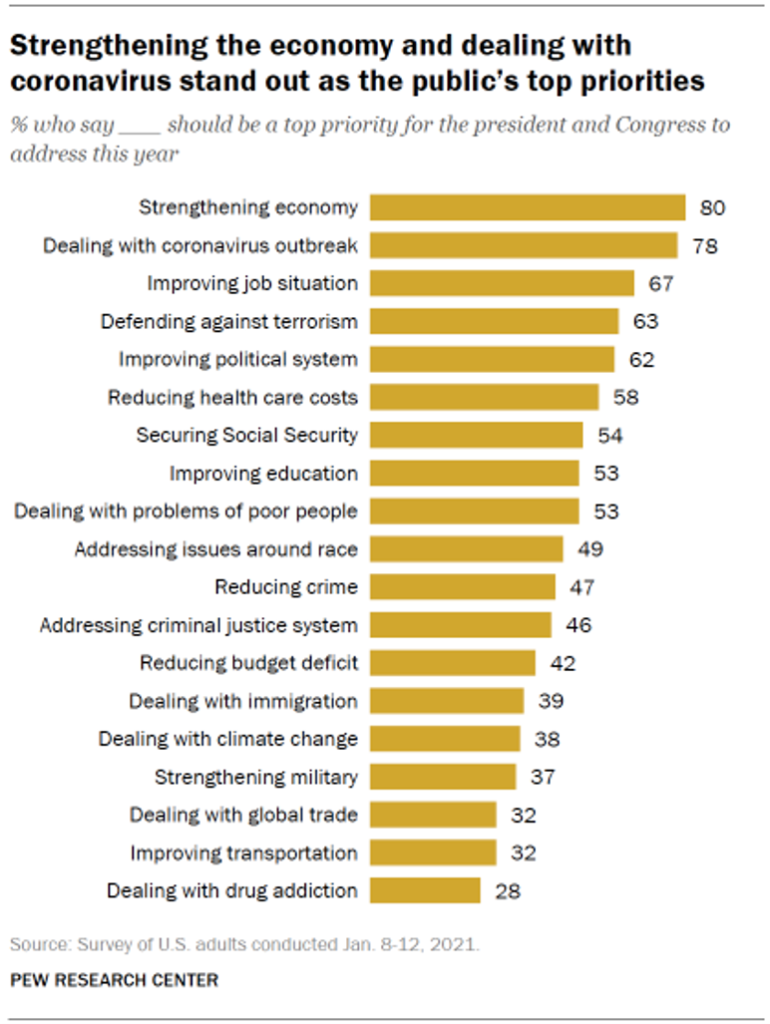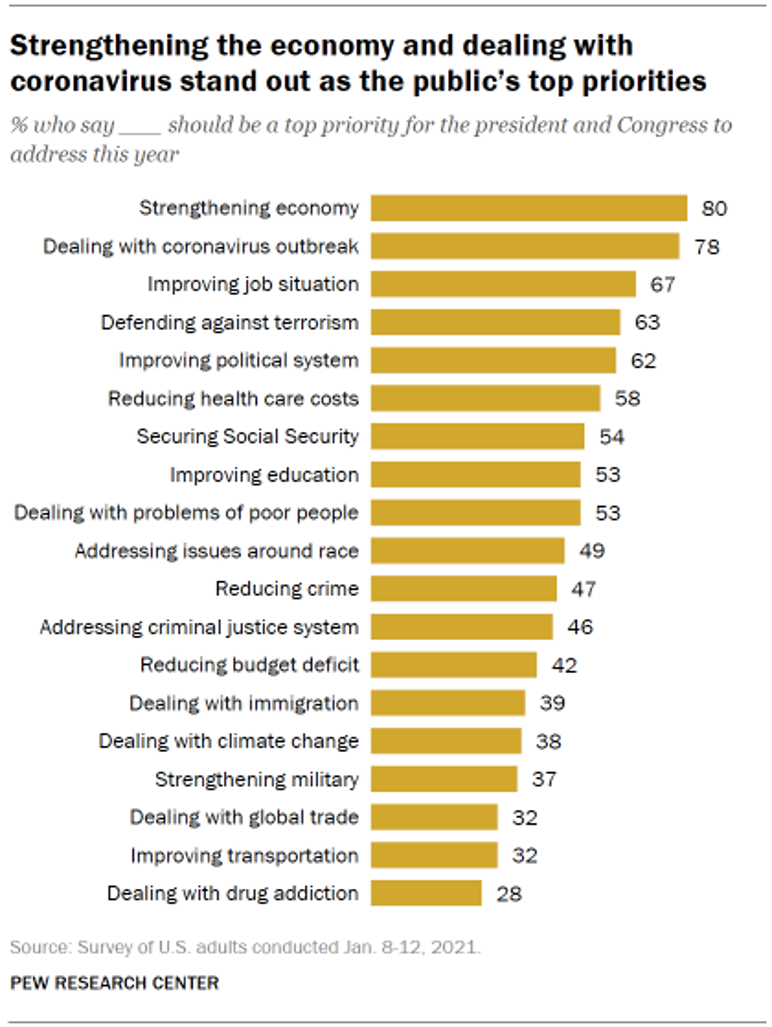Nearly a year into the COVID-19 pandemic, the same percent of Americans say strengthening the U.S. economy and dealing with the coronavirus outbreak should be a top priority for President Biden and Congress to address this year, according to data from the Pew Research Center collected during the second week of January 2021.
 Two-thirds of people in the U.S. also want government leaders to prioritize improving the employment situation, defending against terrorism, and improving the political system, the study learned.
Two-thirds of people in the U.S. also want government leaders to prioritize improving the employment situation, defending against terrorism, and improving the political system, the study learned.
At Americans’ low end of the priority list for the President and Congress are dealing with global trade, improving transportation, and dealing with drug addiction.
The Pew Research Center surveyed 5,360 U.S. adults age 18 and over for this research between 8 and 12 January 2021.
The top half of Americans’ priority list, shown in the first graphic, lean heavily toward the economy and financial issues (e.g., reduce health care costs, improve jobs, secure Social Security, strengthen economy) and socio-political challenges addressing issues around race, improve politics, and dealing with problems of poor people.
Pew gathered demographic details about respondents to the survey, and these are important and informative to mine.
First, partisanship: similar proportions of voters who identify as Republican/Lean Republican and Democrat/Lean Democrat prioritize improving the political system (60% vs. 64%), dealing with immigration (39%/39%), and securing Social Security (54%/51%).
Wide gaps between GOP vis-a-vis Dems are for:
- Addressing issues around race (24% GOP vs. 72% Dem), a 48% delta
- Dealing with global climate change (14% vs. 59%), a 45% delta
- Dealing with the coronavirus outbreak (60% vs. 93%), a 33% delta
- Dealing with problems of poor people (35% vs. 68%), a 33% delta.
Pew also found policy priority differences between race — most notably on addressing issues around race (40% White v. 68% Hispanic v. 83% Black).
But racial differences erode when it comes to some key economic and fiscal issues, such as reducing the budget deficit and strengthening the economy.
 The Mars vs. Venus gaps between women and men are also striking, arrayed in the second chart from the Pew study.
The Mars vs. Venus gaps between women and men are also striking, arrayed in the second chart from the Pew study.
The large chasms in policy priorities between women and men are for issues around race, addressing criminal justice, reducing health care costs, improving education, defending against terrorism, improving jobs, dealing with the problems of the poor, and with immigration.
Those challenges fall into buckets of financial/economic, social and civil justice, and physical safety (e.g., the fear of terrorism — in today’s context, sources potentially domestic and/or out-of-country).
The genders are closely aligned when it comes to reducing the budget deficit, dealing with global trade, improving the political system, strengthening the economy, reducing crime, and improving transportation, all within 5 points of each other.
Younger Americans are relatively further apart from older people on defending against terrorism, strengthening the military, and securing Social Security (the latter of which makes sense in terms of time horizon).
Finally, the demographic of educational level plays into how one person prioritizes a public policy versus another.
Based on the person’s level of education, the greatest gaps in priorities for the President and Congress to deal with in 2021 are for:
- Securing Social Security (a 28 point difference between folks with a post-graduate education compared with people with high school or less education)
- Reducing crime, a 26 point difference (31% postgrad vs. 57% high school or less)
- Strengthening the military, a 23 percentage point delta (25% vs. 48%)
- Defending against terrorism (20 percentage points, 51% vs. 71%).
On the opposite end of the spectrum where more postgrad citizens rank an issue more important than people with high school or less, dealing with climate change ranks first with a 14 percentage point difference — 49% of postgrads compared with 35% people with high school or less.
Based on education, folks are relatively close in terms of percentages prioritizing the issue for education, immigration, and transportation.
Health Populi’s Hot Points: The top-line of this Pew study are that lives and livelihoods put people, across demographic differences, on the same page. Strengthening the economy while ridding our daily lives of the virus and its impacts on our work, education, leisure time, and entertainment options is Job 1/2 for Americans at the start of 2021.
 Check out this third chart, from another Pew Research Center study conducted in the Fall of 2020 published this week. In this research, Pew polled adults over 18 years of age in the U.S., UK, Germany, and France, to compare citizens’ views on the coronavirus pandemic.
Check out this third chart, from another Pew Research Center study conducted in the Fall of 2020 published this week. In this research, Pew polled adults over 18 years of age in the U.S., UK, Germany, and France, to compare citizens’ views on the coronavirus pandemic.
In this data point, we see that more U.S. women than men felt their life had changed a great deal or a fair amount due to the COVID-19 outbreak.
This was the largest proportion of women feeling hurt by the pandemic compared with women in the other three countries.
That’s 4 in 5 American women saying COVID-19 has changed their life by the end of 2020.
It’s clear that the economic impact of the public health crisis has hit women harder than men in America, resulting in the impacts of a “She-Cession.”
[I’ve covered this in detail here in Health Populi; you can start with this post if you want to learn more of the details on the pandemic’s disproportionate impact on American women vs. men].
In today’s White House briefing, Jared Bernstein, a member of the White House Council of Economic Advisors (CEA), called out the weak job growth numbers for the past month, calling it “stalled.”
Bernstein also said, that, “Workers of color have been more likely to lose their jobs than White workers in January,” adding that, “While the unemployment rate for men and women is relatively similar, women have left the labor force in numbers that are of great concern to us.”
Here’s the full coverage of this press event with Bernstein’s full remarks.






 Grateful to Gregg Malkary for inviting me to join his podcast
Grateful to Gregg Malkary for inviting me to join his podcast  This conversation with Lynn Hanessian, chief strategist at Edelman, rings truer in today's context than on the day we recorded it. We're
This conversation with Lynn Hanessian, chief strategist at Edelman, rings truer in today's context than on the day we recorded it. We're